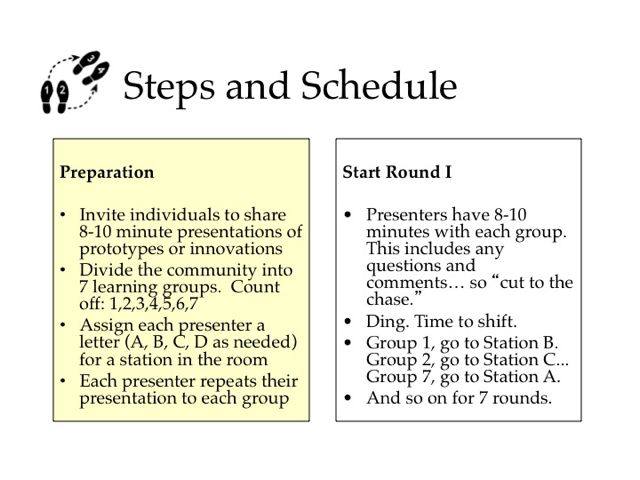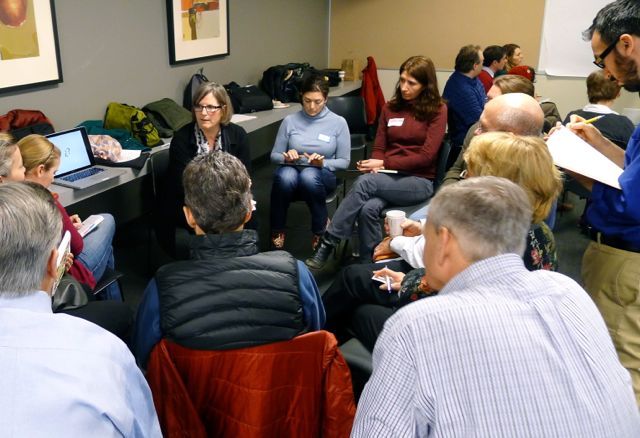![]() Shift & Share
Shift & Share
Spread Good Ideas and Make Informal Connections with Innovators (90 min.)
What is made possible? You can quickly and effectively share several innovations or useful programs that may lie hidden within a group, organization, or community. Shift & Share gets rid of long large-group presentations and replaces them with several concise descriptions made simultaneously to multiple small groups. A few individuals set up “stations” where they share in ten minutes the essence of their innovations that may be of value to others. As small groups move from one innovator’s station to another, their size makes it easy for people to connect with the innovator. They can quickly learn where and how new ideas are being used and how they might be adapted to their own situations. Innovators learn from the repetition, and groups can easily spot opportunities for creative mash-ups of ideas.
Five Structural Elements – Min Specs
1. Structuring Invitation
- Invite participants to visit several innovators who will share something new or innovative they are doing and that may be of value to them
2. How Space Is Arranged and Materials Needed
- A large space where 5 to 8 stations can be set up far enough from each other to minimize interference with one another
- A suitable number of chairs to accommodate the small groups at each station
- Space for a display as needed by presenters
3. How Participation Is Distributed
- A few members of the group, the presenters, share their work
- Everyone else in the small groups has an equal opportunity to participate and contribute
4. How Groups Are Configured
- Presenters set up their individual stations
- The whole group is split into the same number of small groups as there are presenters, for instance, 7 small groups if there are 7 presenters
- Groups stay together while they rotate through all the innovation stations
5. Sequence of Steps and Time Allocation
- Describe the process: explain that small groups will move from station to station for a 10-minute presentation and brief questions and feedback period. If it wasn’t done in advance, identify the 3 to 7 presenters for the innovation stations (can be people who volunteer in the moment). Form the same number of small groups as there are presenters. 5 min.
- Each small group goes to a different station, where presenters conduct their sessions (repeated up to 7 times). 10 min. per station/session
- Participants ask questions or provide feedback. 2 min. per station/session
- Small groups move to the next station. 1 min. per move
- Repeat until groups have visited all stations.
- Total time for visiting 6 stations is approximately 90 minutes.
WHY? Purposes
- Quickly share ideas and innovations
- Enable people to recognize that they are innovating or have the potential to innovate
- Build trust and a community of practice among members
- Reveal how the formal technological hierarchy can obscure the hidden contributions of frontline innovators
- Quickly give participants a sense of the innovation landscape
- Explore and expose bottom-up and fringe-in innovations
- Spark friendly competition, mash-ups, and collaboration
Tips and Traps
- Pick presenters by digging deep into the informal social networks (presentation skills and charisma are less important than content for this approach)
- Keep tightly to the schedule: use a loud sound or tingsha bells to signal the shift from one station to the next
- When possible prepare the presenters: 10 minutes is much shorter than they are used to!
- Invite presenters to tell stories that help the audience make the leap from understanding a small example of behavior change to seeing a broad change in values or a shift in resource allocation, or both
- Invite presenters to supplement their presentations with examples and objects that participants can see and touch
- Encourage presenters to entertain and engage the imagination of the audience
- Trust that people will follow up to get more depth if they are interested
Riffs and Variations
- Invite the roving groups to use What, So What, Now What? to debrief what they experienced
- Like a PechaKucha Night presentation, add snacks and drinks at each station
- Shorten the presentation time to 8 minutes
- Do not establish set groups; instead mash up with Open Space (individuals use their two feet to go where they are most curious about and where they are learning something)
- If you do a second round, leave a few stations open for impromptu presenters
- Use with virtual groups by creating a series of chat rooms. The groups then select a handful of sessions they want to attend
- String together with Improv Prototyping to generate variations on ideas presented
Examples
- For orienting new members of a research consortium to the depth and breadth of innovations within the whole community
- For introducing technology applications at a conference, mixing presenters from within the field with commercial vendors
- For highlighting the programs and people from two “sides” of a newly merged organization
Attribution: Liberating Structure developed by Henri Lipmanowicz and Keith McCandless. Inspired by Chris McCarthy and the Innovation Learning Network.
Collateral Material
Below: Presentation materials we use to introduce Shift & Share

Below: A group gathered for an eight-minute Shift & Share presentation in Seattle

